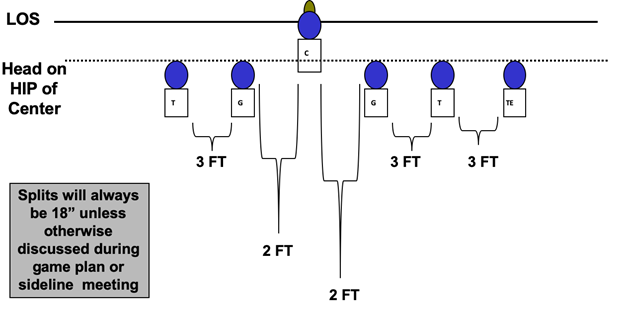Introduction
When it comes with understanding the zone blocking scheme in football-our base run play is known as inside zone and will be installed on day one of practice. Our scheme is rooted in the research done by Alex Gibbs, Joe Bugel, and Russ Grimm. Using a running back out of the backfield, our zone plays will be categorized into two types: Inside Zone (IZ) and Outside Zone (OZ). The running back will have a different landmark for each type of zone and our OL will a slightly different footwork for each scheme as well. However, the basics of each play are similar and make it much easier to install and understand.
The running game is one of the strongest points of any Spread offense. The principal behind the Spread is to spread the field both vertically and horizontally. But doing this you force the defense to also spread out their personnel which causes their players to have to defend more space. Having to occupy and control added space helps to equalize talent levels.
With our Inside Zone and Outside Zone, we have several running plays using these schemes. Using these schemes, it allows us to utilize the skill positions more effectively. Our lineman must understand the Zone Rules and communicate with one another for this system to work.
We will focus on the offensive line for this article and primarily inside zone.
Understanding the Zone Blocking Scheme in Football
Stance and Alignments
We will utilize anywhere from a 2-foot to a 3-foot split upfront.

Incorrect Center Stance
- Butt too low. When too low, you work to being too high.
- Neutral feet in stance (point straight ahead). The hips are closed, can’t work through angles with maximum power.
- Knees over toes. The knees will flare upon initial movement. Less control of hips.
- Rounded lower back. Mitigated power output. Pad level becomes issue.
- Too narrow. False steps. Lateral movement becomes more difficult.
Proper Center Stance
- Toes slightly pointed out. This will keep the hips open.
- Feet slightly wider than shoulders.
- Pull knees in. Gives control on the inner thigh.
- Butt up. Creates an arch in the back (between the shoulders and butt).
Proper 3 Point Stance for Guards and Tackles
We have experimented with two points and have allowed a few players to use them in the past.
Feet
- Armpit apart.
- Slight stagger- weight on inside seam of feet.
- Toes- slightly pigeon-toed.
- Heels- no more than 2″ off the ground.
- Head and Eyes up! Look through eyebrows, to the target.
- Neck- semi-bowed, bot bulled neck.
- Shoulders- parallel to the LOS.
- Back- flat back, not rounded.
- Butt- slightly lower than your back.
Down Hand
- Nails should be white, finder-tips should be red.
- Thumb under eyeball.
- Pinky should be in line with instep.
- Reach out and touch imaginary wall then go down.
Inside Zone Technique- Covered Linemen / Uncovered Linemen
Outside Zone Technique- Covered Linemen / Uncovered Linemen
Successful Zone Blocking
Starts with counting to 3 on every play! We tell our players if you can count to three, you can block for me.
Rules to live by with Zone Blocking
- Know if you are covered or uncovered.
- Identify your man.
- Know your steps and calls.
- The occurs after contact. Be aggressive, run your feet. Make your splits work for your advantage. 4 hands on DLM, 4 eyes on LB. Vertical push on IZ (inside zone).
- Communicate with each other.
- Always finish your block.
Understanding the Zone Blocking Scheme in Football-Blocking Scheme / Rules
How you’re going to block your man? First identify your man (#) then follow the covered / uncovered rule:
Covered- you are man blocking automatically (no help).
-Unless- you hear your uncovered partner call your name at the LOS, or Tag play where we motion someone to help you.
-Aim point- plays-side corner of the facemask of the DLM.
Uncovered- Zone (combo) with your teammate to the play-side.
-Call his name to identify a combo block.
-Aim point- backside shoulder of the DLM.
Zone Right
Conclusion
Zone blocking doesn’t have to be hard or too complicated. Start with technique and counting. Teach your offensive line who they are blocking and why they are blocking them. In future articles, I will discuss the running backs role in IZ and talk about how we block OZ in more detail. Once this base play is installed and established there are many variations of the play and tags that make it one of the most versatile plays in football. I hope you enjoyed this article on Understanding the Zone Blocking Scheme in Football.
SEE ALSO: Inside & Outside Zone Playbook for Youth Football
SEE ALSO: Maximizing the Outside Zone Blocking Scheme
Mike Wilson
Head Coach
A.P. Schalick High School, New Jersey
Twitter: @wilson2882
Email: wilson2882@yahoo.com
